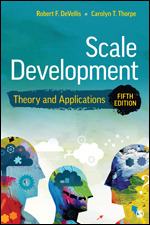Scale Development
Theory and Applications
Fifth Edition
- Robert F. DeVellis - The University of North Carolina at Chapel Hill, USA
- Carolyn T. Thorpe - The University of North Carolina at Chapel Hill, USA
August 2021 | 320 pages | SAGE Publications, Inc
Scale Development: Theory and Applications, by Robert F. DeVellis and new co-author Carolyn T. Thorpe, demystifies measurement by emphasizing a logical rather than strictly mathematical understanding of concepts. The Fifth Edition includes a new chapter that lays out the key concepts that distinguish indices from scales, contrasts various types of indices, suggests approaches for developing them, reviews validity and reliability issues, and discusses in broad terms some analytic approaches. All chapters have been updated, and the book strikes a balance between including relevant topics and highlighting recent developments in measurement while retaining an accessible, user-friendly approach to the material covered.
Preface
Acknowledgments
About the Authors
Chapter 1 • Overview
Chapter 2 • Understanding the Latent Variable
Chapter 3 • Scale Reliability
Chapter 4 • Scale Validity
Chapter 5 • Guidelines in Scale Development
Chapter 6 • Factor Analysis
Chapter 7 • The Index
Chapter 8 • An Overview of Item Response Theory
Chapter 9 • Measurement in the Broader Research Context
References
The book have everything what is need it for the course. The graduate students will find very useful the procedure and recommendations of the authors. The title is very well written and straight to the point.
Business Administration, Universidad de Monterrey
February 13, 2023
It is a good text, thorough and rigorous.
Psychology Dept, Northwest University
December 19, 2022
